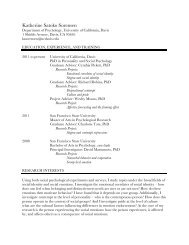SMART Board User's Guide - Psychology
SMART Board User's Guide - Psychology
SMART Board User's Guide - Psychology
You also want an ePaper? Increase the reach of your titles
YUMPU automatically turns print PDFs into web optimized ePapers that Google loves.
To create a new Notebook file:<br />
1 Select New from the File menu.<br />
or<br />
Press the New Document button.<br />
The blank workspace represents the first page of the newly created Notebook file.<br />
2 Add whatever pages, annotations, captures and images you want to the file.<br />
3 Save the file.<br />
To save a new, unnamed Notebook file:<br />
1 Select Save from the File menu.<br />
or<br />
If you want to save the file for use with a previous version of <strong>SMART</strong> Notebook<br />
software (version 1.0 or 1.1), select Save As from the File menu.<br />
The Save or Save As dialog box will appear.<br />
2 In the Save As (Macintosh operating systems) or File name (Windows operating<br />
systems) text box, type a name, using the default .nbk file extension.<br />
The new Notebook file will be automatically saved in the current directory and drive<br />
unless you specify otherwise (see step 3).<br />
3 To store the new Notebook file in a different directory and drive, press the scroll arrow<br />
in the Save in box and select the directory and drive in which you want to store the<br />
new Notebook file.<br />
4 If you selected Save As, you can save the current Notebook file for use with previous<br />
versions of <strong>SMART</strong> Notebook software by selecting <strong>SMART</strong> Notebook 1.0 or <strong>SMART</strong><br />
Notebook 1.1 selection in the Save as type drop-down list.<br />
Users of Windows operating systems can also save the file as a NetMeeting<br />
Whiteboard file by selecting NetMeeting 2.0 Whiteboard 256 colors in the Save as<br />
type drop-down list. Or you can save the Notebook file in .xbk extension, which saves<br />
the file in a format readable by Mac OS X and UNIX operating systems.<br />
To save a Notebook file as image files:<br />
NOTE: This feature isn't available for Mac OS X operating system.<br />
1 Select Save As Image Files from the File menu.<br />
The Save As Image Files wizard will appear.<br />
2 Specify a graphic format.<br />
3 Specify a directory for the graphic files by pressing the Browse button and navigating<br />
to an appropriate directory location. By default the image files are saved to the same<br />
directory as the Notebook file. However, we recommend that you create a new folder<br />
to hold all your image files. If you enter the name of a folder that doesn’t yet exist, you’ll<br />
be asked if you want to create a new folder.<br />
4 Press Next.<br />
5 Specify a base name for the image files.<br />
NOTE: Each page in a Notebook file is saved using this base name and a page<br />
number. This base name is also applied to the folder that contains the group of files<br />
that make up the pages.<br />
6 Press Next.<br />
Win<br />
<strong>SMART</strong> <strong>Board</strong> User’s <strong>Guide</strong> 57
















